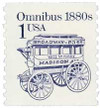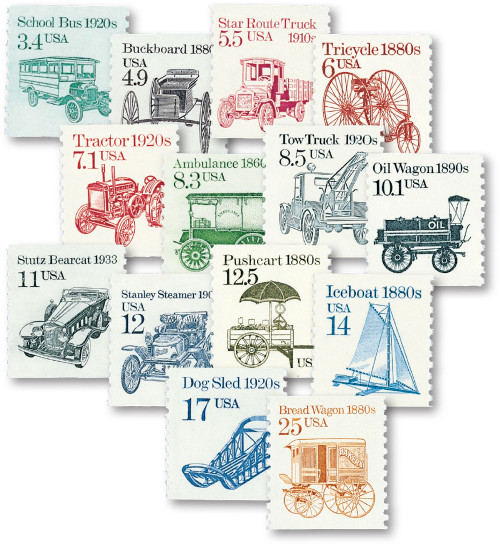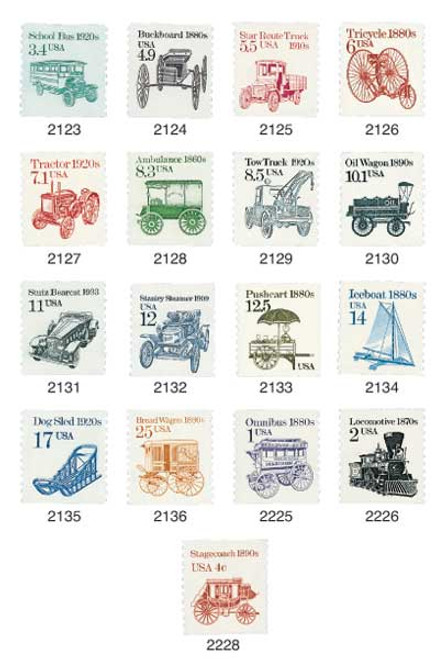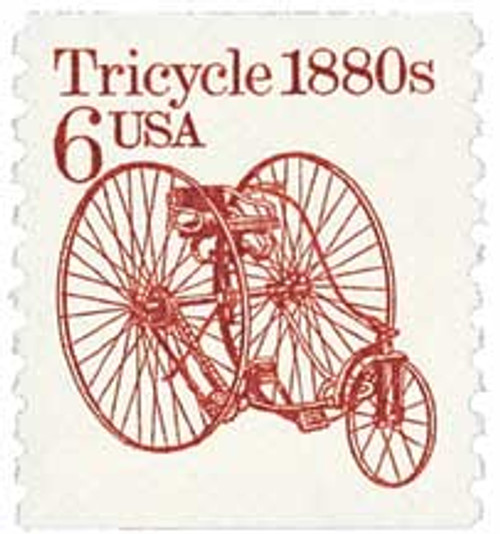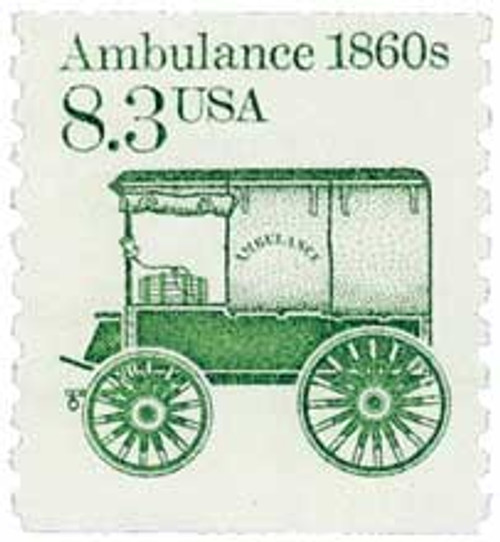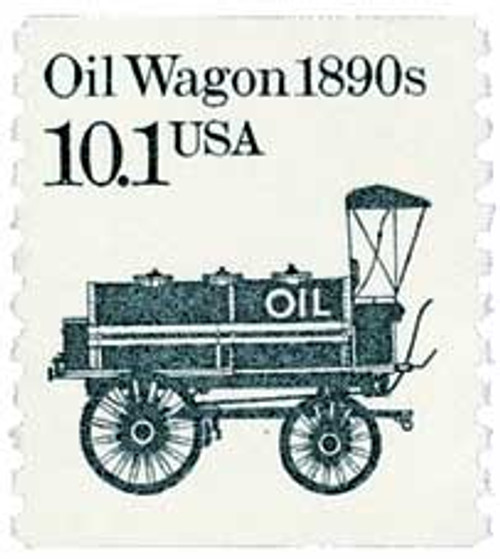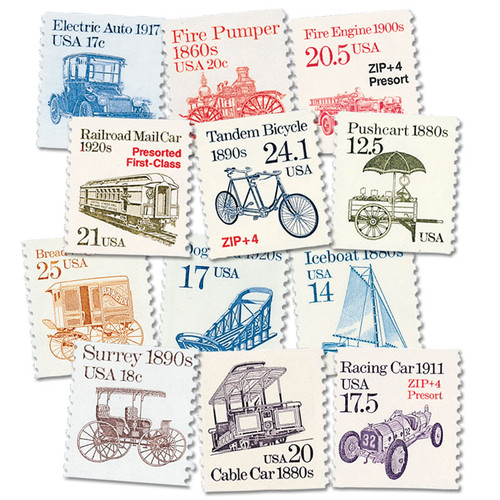
# 2225 - 1986 1c Transportation Series: Omnibus, 1880s, re-engraved
U.S. #2225
1986 1¢ Omnibus, 1880s, re-engraved
Transportation Series
- Re-engraving of 1983 Omnibus stamp
- Fifth re-engraved Transportation stamp; first with issue date announced
Stamp Category: Definitive
Series: Transportation
Value: 1¢, used for change making at vending machines.
First Day of Issue: November 26, 1986
First Day City: Washington, DC
Quantity Issued: 255,000,000
Printed by: Bureau of Engraving and Printing
Printing Method: Engraved
Format: Coils of 3,000
Perforations: 10 Vertical
Color: Violet
Why the stamp was issued: This stamp is a re-engraving of the 1983 Omnibus stamp, used for making change at vending machines.
Several of the early Transportation stamps had been printed on the Cottrell presses, which were no longer in use. Over time, they needed to print more stamps of certain denominations. When possible, they reused the same master die. But some stamps with designs larger than .73 inches needed to be re-engraved. This Omnibus stamp was among those to be re-engraved. The new stamp had several small differences from the original stamp.
About the stamp design: This stamp features the same design as US #1897. This re-engraved version has a larger numeral "1", while the central design was made 1 mm smaller. The "USA" came after the value instead of preceding it, and the cent mark entirely disappeared.
First Day City: There was no First Day ceremony planned for this stamp, and the USPS originally said it wouldn’t offer first day cancellations either. However, because collector demand for First Day Covers for these re-engravings had been strong, the USPS offered this stamp with a first day cancel. It was the first of the re-engravings to receive a first day cancel.
Unusual fact about this stamp: Error varieties exist untagged and imperforate.
About the Transportation Series: On May 18, 1981, the USPS issued the first stamp in the Transportation Series, US #1907, picturing the Surrey, a doorless four-wheeled carriage. For the first time in US history, a coil stamp featured its own unique design rather than simply copying that of the current definitive stamp. Over 50 more coil stamps would be issued over the course of the next 15 years, each picturing a different mode of transportation. All of these types of transportation were used since American independence.
The various denominations provided face values to exactly match the rates for several categories of Third-Class mail (bulk rate and quantity-discounted mail). As the rates changed, new stamps with new values were added. Never before had a stamp series included so many fractional cent values.
The Bureau of Engraving and Printing printed most of the stamps in the Transportation Series, although private contractors printed a few. All but a few of the later stamps were produced by engraved intaglio. Differences in precancels, tagging, paper and gum provide a large number of varieties.
Scott Catalog separates the Transportation stamps into four groups. The stamps in the first group (#1897-1908) generally have the denomination in small type with a “c” next to it. These stamps were printed on the Cottrell rotary press, which joined together two plates to make a sleeve. The gaps between these plates created depressions where ink would collect and create joint lines on the stamps. Later issues were printed on a different press and didn’t have these joint lines.
The second group (#2123-36) had larger numbers with no “c.” The third group (#2252-66) was similar in appearance to the second group, but service inscriptions were added to the designs. These stamps also used a variety of paper and gum as well as different types of tagging. The fourth group (#2451-68) marked the end of fractional values. Now bulk mailers would use either the 5¢ or 10¢ stamp and then pay the difference from the actual postage rate.
The last stamp in the Transportation Series, the 20¢ Cog Railway, was issued on June 9, 1995, at the TEXPEX ’95 stamp show in Dallas, Texas. This marked the end of the largest US definitive series up to that time and the largest US coil stamp series in history. Three new series would eventually replace it – American Transportation, American Culture, and American Scenes. Additionally, the Great Americans would go on to become the largest American definitive series.
History the stamp represents: A forerunner of today’s buses, the omnibus was used in US cities during the late 1800s for public mass transportation. These large, horse drawn wagons were developed in Paris and were used throughout France as early as the 1830s.
U.S. #2225
1986 1¢ Omnibus, 1880s, re-engraved
Transportation Series
- Re-engraving of 1983 Omnibus stamp
- Fifth re-engraved Transportation stamp; first with issue date announced
Stamp Category: Definitive
Series: Transportation
Value: 1¢, used for change making at vending machines.
First Day of Issue: November 26, 1986
First Day City: Washington, DC
Quantity Issued: 255,000,000
Printed by: Bureau of Engraving and Printing
Printing Method: Engraved
Format: Coils of 3,000
Perforations: 10 Vertical
Color: Violet
Why the stamp was issued: This stamp is a re-engraving of the 1983 Omnibus stamp, used for making change at vending machines.
Several of the early Transportation stamps had been printed on the Cottrell presses, which were no longer in use. Over time, they needed to print more stamps of certain denominations. When possible, they reused the same master die. But some stamps with designs larger than .73 inches needed to be re-engraved. This Omnibus stamp was among those to be re-engraved. The new stamp had several small differences from the original stamp.
About the stamp design: This stamp features the same design as US #1897. This re-engraved version has a larger numeral "1", while the central design was made 1 mm smaller. The "USA" came after the value instead of preceding it, and the cent mark entirely disappeared.
First Day City: There was no First Day ceremony planned for this stamp, and the USPS originally said it wouldn’t offer first day cancellations either. However, because collector demand for First Day Covers for these re-engravings had been strong, the USPS offered this stamp with a first day cancel. It was the first of the re-engravings to receive a first day cancel.
Unusual fact about this stamp: Error varieties exist untagged and imperforate.
About the Transportation Series: On May 18, 1981, the USPS issued the first stamp in the Transportation Series, US #1907, picturing the Surrey, a doorless four-wheeled carriage. For the first time in US history, a coil stamp featured its own unique design rather than simply copying that of the current definitive stamp. Over 50 more coil stamps would be issued over the course of the next 15 years, each picturing a different mode of transportation. All of these types of transportation were used since American independence.
The various denominations provided face values to exactly match the rates for several categories of Third-Class mail (bulk rate and quantity-discounted mail). As the rates changed, new stamps with new values were added. Never before had a stamp series included so many fractional cent values.
The Bureau of Engraving and Printing printed most of the stamps in the Transportation Series, although private contractors printed a few. All but a few of the later stamps were produced by engraved intaglio. Differences in precancels, tagging, paper and gum provide a large number of varieties.
Scott Catalog separates the Transportation stamps into four groups. The stamps in the first group (#1897-1908) generally have the denomination in small type with a “c” next to it. These stamps were printed on the Cottrell rotary press, which joined together two plates to make a sleeve. The gaps between these plates created depressions where ink would collect and create joint lines on the stamps. Later issues were printed on a different press and didn’t have these joint lines.
The second group (#2123-36) had larger numbers with no “c.” The third group (#2252-66) was similar in appearance to the second group, but service inscriptions were added to the designs. These stamps also used a variety of paper and gum as well as different types of tagging. The fourth group (#2451-68) marked the end of fractional values. Now bulk mailers would use either the 5¢ or 10¢ stamp and then pay the difference from the actual postage rate.
The last stamp in the Transportation Series, the 20¢ Cog Railway, was issued on June 9, 1995, at the TEXPEX ’95 stamp show in Dallas, Texas. This marked the end of the largest US definitive series up to that time and the largest US coil stamp series in history. Three new series would eventually replace it – American Transportation, American Culture, and American Scenes. Additionally, the Great Americans would go on to become the largest American definitive series.
History the stamp represents: A forerunner of today’s buses, the omnibus was used in US cities during the late 1800s for public mass transportation. These large, horse drawn wagons were developed in Paris and were used throughout France as early as the 1830s.






